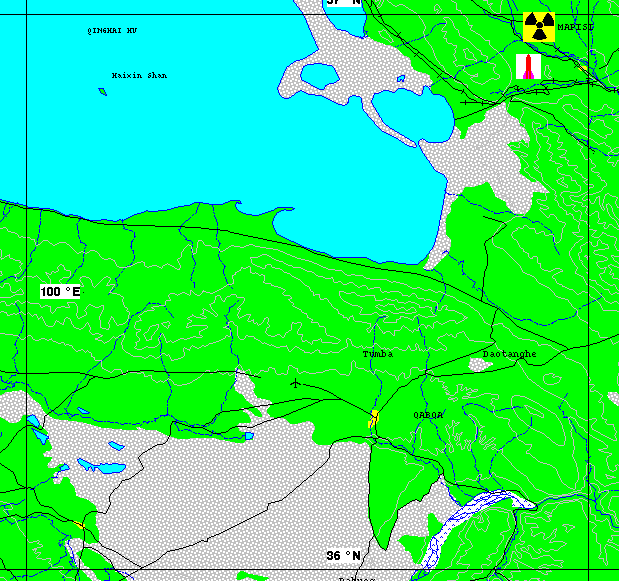





In the late 1960s as part of the "third line" effort to relocate critical defense infrastructure in the relatively remote interior, China built new [allegedly underground] facilities supplement the plutonium production reactor at Jiuquan [third line plutonium production reactor at Guangyuan ], the design and fabrication facility at Haiyan [third line design and fabrication facility at Mianyang ], and the gaseous diffusion plant at Lanzhou [third line plutonium processing facility at Yibin ].
China's first nuclear weapons research and development facility is situated 10 miles (16.1 km) east of Lake Kokonor [Qinghai Lake] in Haiyan County [said by one authoritative source to be at 36�57'N 101�55'E, though this is evidently a typographic error]. With construction starting in 1958, the facility was given the formal designation of State Plant 221, also known as the Qinghai Provincial Mining Zone. It is also known as the Northwest Nuclear Weapons Research & Design Academy, or the Ninth Academy, under the jurisdiction of the Ninth Bureau. China's first atomic bomb and first hydrogen bomb were successfully developed there, hence the local name "two-bomb base." Under the direction of by Marshal Nie Rongzhen, between 1958 and 1964, the facility developed China's first atomic bomb, and two years later the first Chinese hydrogen bomb. The 1,100 square kilometer base was a closed city, and all activities of its personnel were conducted within the facility. The facility includes 560,000 sq. m of buildings inside plant premises, 330,000 sq. m of production buildings, more than 40 km of special railway lines which converge with the Qinghai- Tibet Railway Line, nearly 80 km of standard highways, 1,000 six- digit computer-controlled telephones, and one thermal power plant with an annual generating capacity of 110 million kwh.In 1987 the State Council approved the closure of the facility, and personnel were gradually shifted to other facilities. The former facility has become the seat of the Haibei Zang Nationality Autonomous Prefecture Government of Qinghai Province. In June 1994 the Beihai Autonomous Prefecture signed a transfer contract with the China National Nuclear Industry Corporation. The Haibei Autonomous Prefecture Government designated the site as a "small zone for national economy development"
DF-3 training also has been observed at Haiyan, indicating continued Chinese reliance on the older IRBM.

